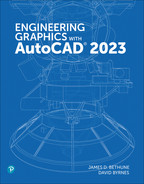Preface
This text teaches technical drawing and uses AutoCAD 2023 as its drawing instrument. Although it follows the general format of many technical drawing texts and presents much of the same material about drawing conventions and practices, the emphasis is on creating accurate, clear drawings. For example, the text shows how to locate dimensions on a drawing so that they completely define the object in accordance with ASME Y14.5-2009 national standards, but the presentation centers on the AutoCAD’s Dimensions panel and its associated tools and options. The standards and conventions are presented and their applications are shown with the use of AutoCAD 2023. This integrated teaching concept is followed throughout the text.
Most chapters include drawing problems. The drawing problems are varied in scope and are open-ended, which means that there are several correct solutions. This is intended to encourage student creativity and increase their problem-solving abilities.
Chapters 1 through 3 cover tools on the Draw and Modify panels of the Home tab of AutoCAD’s ribbon, and other commands needed to set up and start drawings. The text starts with simple Line commands and proceeds through geometric constructions. The final sections of Chapter 3 describe how to bisect a line and how to draw a hyperbola, a parabola, a helix, and an ogee curve. Redrawing many of the classic geometric shapes will help students learn how to use the Draw and Modify panels and other associated commands with accuracy and creativity.
Chapter 4 presents freehand sketching. Simply stated, there is still an important place for sketching in technical drawing. Many design ideas start as freehand sketches and are then developed on a computer. This chapter now includes extensive exercise problems associated with visual orientation.
Chapter 5 presents orthographic views. Students are shown how to draw three views of an object using AutoCAD 2023. The discussion includes projection theory, hidden lines, compound lines, oblique surfaces, rounded surfaces, holes, irregular surfaces, castings, and thin-walled objects. The chapter ends with several intersection problems. These problems serve as a good way to pull together orthographic views and projection theory. Several new, more difficult, exercise problems have been added to this edition. The chapter also includes an explanation of the differences between first- and third-angle projections as defined by ANSI and ISO conventions. Appropriate exercise problems help reinforce the understanding of the differences between the two standards.
Chapter 6 presents sectional views and introduces the Hatch and Gradient commands. The chapter includes multiple, broken-out, and partial sectional views and shows how to draw an S-break for a hollow cylinder.
Chapter 7 covers auxiliary views and shows how to use the Snap, Rotate command to create axes aligned with slanted surfaces. Secondary auxiliary views are also discussed. Solid modeling greatly simplifies the determination of the true shape of a line or plane, but a few examples of secondary auxiliary views help students refine their understanding of orthographic views and, eventually, the application of user coordinate systems (UCSs).
Chapter 8 shows how to dimension both two-dimensional shapes and orthographic views. The Dimension tools and their associated commands are demonstrated, and examples of how to use the Dimension Styles tool are included. The commands are presented as needed to create required dimensions. The conventions demonstrated are in compliance with ANSI Y14.5-2009.
Chapter 9 introduces tolerances. The chapter shows how to draw dimensions and tolerances using the Dimension and Tolerance commands, among others. The chapter ends with an explanation of fit types, and shows how to use the tables included in the Appendix to determine the maximum and minimum tolerances for matching holes and shafts.
Chapter 10 discusses the use of geometric tolerances and explains how AutoCAD 2023 can be used to create geometric tolerance symbols directly from dialog boxes. Both profile and positional tolerances are explained. The overall intent of the chapter is to teach students how to make parts fit together. Fixed and floating fastener applications are discussed, and design examples are given for both conditions.
Chapter 11 covers how to draw and design with the use of standard fasteners, including bolts, nuts, machine screws, washers, hexagon heads, square heads, set screws, rivets, and springs. Students are shown how to use the Wblock command to create drawings of the individual thread representations and how to use them for different size requirements.
Chapter 12 discusses assembly drawings, detail drawings, and parts lists. Instructions for drawing title blocks, tolerance blocks, release blocks, and revision blocks, and for inserting drawing notes are also included to give students better preparation for industrial practices.
Chapter 13 presents gears, cams, and bearings. The chapter teaches how to design by using gears selected from manufacturers’ catalogs and websites. The chapter shows how to select bearings to support gear shafts and how to tolerance holes in support plates to maintain the desired center distances of meshing gears. It also explains how to create a displacement diagram and then draw the appropriate cam profile.
Chapter 14 introduces AutoCAD 3D capabilities. Both parallel (isometric) and perspective grids, as well as the world coordinate system (WCS) and user-defined coordinate systems (UCSs) are demonstrated so students learn the fundamentals of 3D drawings before drawing objects.
Chapter 15 shows how to create three-dimensional solid models. It includes examples of both parallel and perspective grids and using different Visual Style options. The chapter shows how to union, subtract, and intersect primitive shapes to create more complex models and orthographic views from those models.
Chapter 16, which is available online, presents two project problems: a milling vise and a tenon jig. These problems can be used for group or individual projects. These projects are intended to help students learn to work in groups and work on large, complex projects. This chapter can be found on the web as a supplement to the Instructor’s Manual by registering your book at https://www.pearson.com/us/higher-education/subject-catalog/download-instructor-resources.html. Instructors may distribute this URL to students.
